人教版七年级上册英语语法整理
人教版七年级英语上册语法必必背
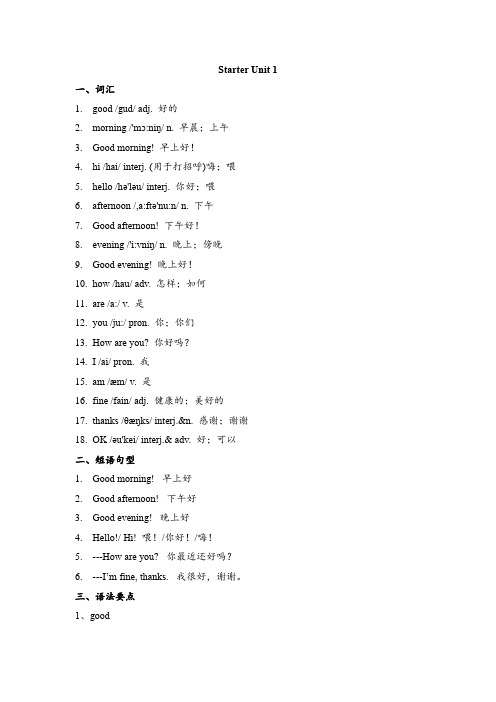
Starter Unit 1一、词汇1.good /gud/ adj. 好的2.morning /'mɔ:niŋ/ n. 早晨;上午3.Good morning! 早上好!4.hi /hai/ interj. (用于打招呼)嗨;喂5.hello /hə'ləu/ interj. 你好;喂6.afternoon /,a:ftə'nu:n/ n. 下午7.Good afternoon! 下午好!8.evening /'i:vniŋ/ n. 晚上;傍晚9.Good evening! 晚上好!10.how /hau/ adv. 怎样;如何11.are /a:/ v. 是12.you /ju:/ pron. 你;你们13.How are you? 你好吗?14.I /ai/ pron. 我15.am /æm/ v. 是16.fine /fain/ adj. 健康的;美好的17.thanks /θæŋks/ interj.&n. 感谢;谢谢18.OK /əu'kei/ interj.& adv. 好;可以二、短语句型1.Good morning!早上好2.Good afternoon!下午好3.Good evening!晚上好4.Hello!/ Hi! 喂!/你好!/嗨!5.---How are you?你最近还好吗?6.---I’m fine, thanks.我很好,谢谢。
三、语法要点1、goodgoods n.(pl.)货物;商品be good for...对...有益/有用be good at...擅长于.2、morning n.早晨;上午“在早上、下午、晚上”用介词in,即in the morning/aftermoon/evening而在具体某一天的早上、下午、晚上用on,如:on Mondaymorning“在周一早上”。
人教版七年级上册英语语法总结
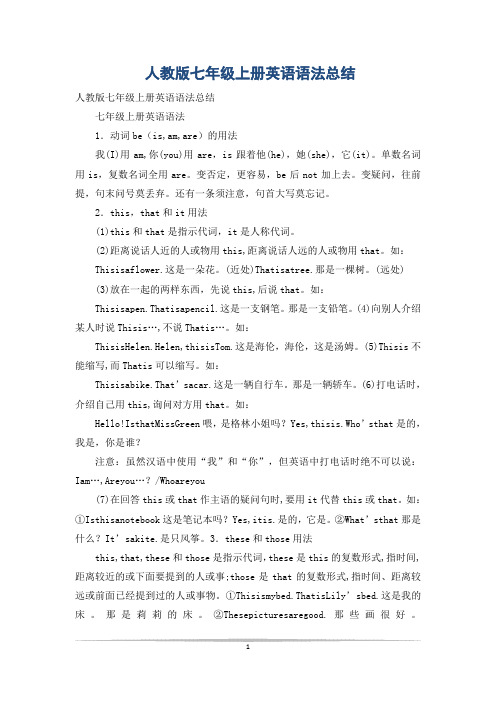
人教版七年级上册英语语法总结人教版七年级上册英语语法总结七年级上册英语语法1.动词be(is,am,are)的用法我(I)用am,你(you)用are,is跟着他(he),她(she),它(it)。
单数名词用is,复数名词全用are。
变否定,更容易,be后not加上去。
变疑问,往前提,句末问号莫丢弃。
还有一条须注意,句首大写莫忘记。
2.this,that和it用法(1)this和that是指示代词,it是人称代词。
(2)距离说话人近的人或物用this,距离说话人远的人或物用that。
如:Thisisaflower.这是一朵花。
(近处)Thatisatree.那是一棵树。
(远处)(3)放在一起的两样东西,先说this,后说that。
如:Thisisapen.Thatisapencil.这是一支钢笔。
那是一支铅笔。
(4)向别人介绍某人时说Thisis…,不说Thatis…。
如:ThisisHelen.Helen,thisisTom.这是海伦,海伦,这是汤姆。
(5)Thisis不能缩写,而Thatis可以缩写。
如:Thisisabike.That’sacar.这是一辆自行车。
那是一辆轿车。
(6)打电话时,介绍自己用this,询问对方用that。
如:Hello!IsthatMissGreen喂,是格林小姐吗?Yes,thisis.Who’sthat是的,我是,你是谁?注意:虽然汉语中使用“我”和“你”,但英语中打电话时绝不可以说:Iam…,Areyou…?/Whoareyou(7)在回答this或that作主语的疑问句时,要用it代替this或that。
如:①Isthisanotebook这是笔记本吗?Yes,itis.是的,它是。
②What’sthat那是什么?It’sakite.是只风筝。
3.these和those用法this,that,these和those是指示代词,these是this的复数形式,指时间,距离较近的或下面要提到的人或事;those是that的复数形式,指时间、距离较远或前面已经提到过的人或事物。
人教版初中英语七年级上册语法知识点
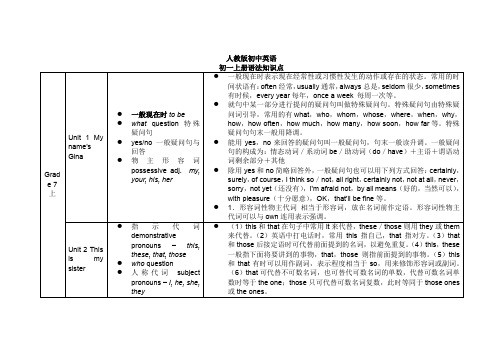
have表示“有”时,其否定形式有两种:在其后直接加not,但常用于非正式用语中;利用助动词do加not。
②如果句子的谓语是实义动词,在谓语动词前加don't,doesn't,didn't。
③no,never,seldom,hardly,nobody,little,few,nothing等否定词也可以构成否定形式。
1.表示经常性或习惯性发生的动作2.表示现在存在的状态或情况3.表示正在发生的动作或存在的状态4.表示客观事实、真理和自然现象5.用于表示较固定的、按计划、规定将要发生的动作,但只限于begin,come,go,leave,arrive,stop,return,close,open,take,start,take,place等少数动作,6.用于if,unless,once,even if(即使)等引导的条件状语从句,when,before,until,as soon as,the moment(一……就)等引导的时间状语从句,no matter+wh-/-how-或wh-ever/however等引导的让步状语从句中,代替一般将来时
人教版初中英语
初一上册语法知识点
Grade 7
上
Unit 1 My name’s Gina
人教版初中英语七年级上册全册各单元知识点、语法归纳整理

人教版初中英语七年级上册全册各单元知识点、语法归纳整理She’s my sister.她是我的妹妹。
3.This is a picture of my family.这是我家人的一张照片。
4.In the first photo。
there’s my XXX.在第一张照片里,有我的爷爷。
5.This is my family tree.这是我的家谱。
6.What’s the name of your father?你父亲叫什么名字?7.Have a good day!过得愉快!重点语法1.名词所有格2.复数形式3.人称代词宾格4.指示代词this和these的用法5.介绍人物时的基本用语:This is …/These are…1.指示代词:this。
that。
these。
those - 这个,那个,这些,那些2.名词复数规则:1)一般情况下直接加s。
2)以s,x,sh,ch结尾的加es。
3)以辅音字母加y结尾的将y变i再加es。
4)以o结尾的加s或es。
(有生命+es物生命加s)5)以f/fe结尾的名词,先将f/fv变成v再加es。
3.人称代词:I。
he。
she。
it和they - 我,他,她,它,他们/她们/它们4.重点短语:Is this/that your。
- 这/那是你的……吗?Yes。
it is。
/ No。
it isn't。
- 是的,是它。
/ 不,不是。
XXX。
- 这些/那些是我的……Here are。
- 这里有……This/That is my。
- 这/那是我的……Have a good day。
- 祝你玩得愉快!Excuse me for interrupting。
but could I ask you a n?Thank you very much.Could you please speak in English?Do you enjoy playing computer games?Have you checked in the lost and found case to see if your item is there?Please call 685-6034 to reach me.I lost my school ID card and need to find it.I need a set of pencils for my art class.Key XXX structures:Is that your school bag?No。
人教版七年级英语上册重点单词短语语法

人教版七年级英语上册重点单词短语语法Starter unit 11. 短语归纳:good morning 早上好good afternoon 下午好good evening 晚上好name list 名单an English name 英文名字2. 必背典句:(1)Good morning! 早上好!(2)Good afternoon! 下午好!(3)Good evening 晚上好!3.英语中常见的问候语(1) Hello!“你好!”是比较随便、不分时间的一种问候语,通常用于打招呼、打电话。
表示惊讶或引起对方注意。
对方应答仍用Hello!(2) Hi!“你好!”的使用比hello!更随便,在年轻人中使用更为普遍。
(3) Nice to meet you!“很高兴见到你!”是两个初次见面、经介绍相识的人互相打招呼的用于。
回答时可以说Nice to meet you, too.或者Me, too.表示“见到你很高兴”(4) How do you do?“你好!”用于初次见面,是非正式的打招呼用语。
对方应答语应是“Howdo you do?”(5)How are you? 表示问候How are you? 意为“你好吗?”,为询问对方身体状况的问候语,应答语一般是“I’m fine.Thank you. / I’m very well. Thank you. / I’m OK.How are you? 的其他用法:习惯上回答完别人的问候后,常可反问对方的身体状况,此时可用How are you?也可用And you? “你呢?”4.大写字母的用法:(1) 在英语中,句子的第一个单词的第一个字母都应大写。
Sit down, please. 请坐。
(2)字母I作人称代词时,意为“我”,在句中任何位置都必须大写。
日常用语“OK”在句中任何位置都大写。
I’m a student. 我是一名学生。
Is everything OK? 一切都好吗?(3)人名、地名、国名、某国人或某种语言等专有名词的第一个字母都必须大写。
人教版七年级上册英语语法归纳
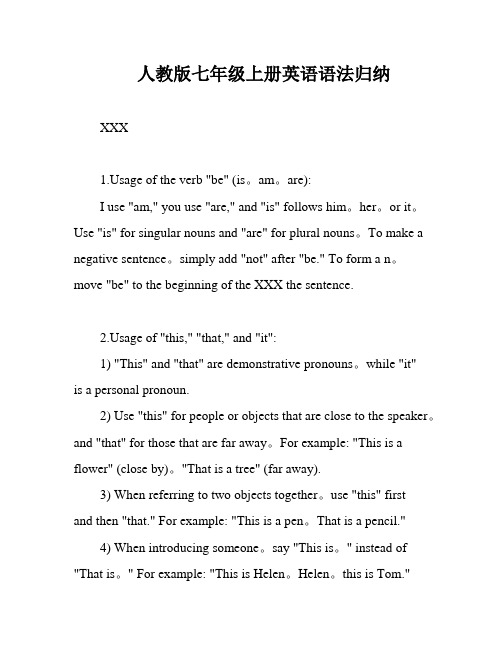
人教版七年级上册英语语法归纳XXXage of the verb "be" (is。
am。
are):I use "am," you use "are," and "is" follows him。
her。
or it。
Use "is" for singular nouns and "are" for plural nouns。
To make a negative sentence。
simply add "not" after "be." To form a n。
move "be" to the beginning of the XXX the sentence.age of "this," "that," and "it":1) "This" and "that" are demonstrative pronouns。
while "it"is a personal pronoun.2) Use "this" for people or objects that are close to the speaker。
and "that" for those that are far away。
For example: "This is a flower" (close by)。
"That is a tree" (far away).3) When referring to two objects together。
use "this" firstand then "that." For example: "This is a pen。
人教版七年级英语上册重点短语总汇,语法总结

人教版七年级英语上册重点短语总汇,语法总结句型(1)-What+be+主语+doing? ….正在做什么?-主语+be+doing。
…正在做某事。
例:-what are you doing?-I’m doing my homework.(2)-Thanks for … 为。
而感谢例:Thanks for your letter.(3)-Here are/is…例:Here are some of my photos.Here is a photo of my family.(4)-That sounds good.(5)-This TV show is boring.三、日常交际用语(1)-Do you want to go to the movices? –Sure.(2)-When do you want to go? –Let’s go at seven.(3)-Where do people play basketball? –At school.(4)-What’s he waiting for?-He’s waiting for a bus.(5)-What’s he reading? He’s reading a newspaper.1)现在在进行时的形式是:助动词be(am,is,are)+动词-ing形式(也叫现在分词),表示现在(说话的瞬间)正在进行或发生的动作。
2)现在进行时的肯定句形式主语+be(am,is,are)+动词现在分词+其他I’m watching TV.3)现在进行时的否定句形式主语+be(am,is,are)+not+动词现在分词+其他They are not playing soccer.4)现在进行时的一般疑问句形式及回答:Is(am,are)+主语+动词现在分词+其他?Yes,主语+is/am/are. No,主语+isn’t/aren’t/am not.Are you reading? Yes,I am. No,I am not.5) 现在进行时的特殊疑问句形式:特殊疑问词+is/am/are+主语+现在分词+其他?例:What is your brother doing?6) 动词+ing形式(现在分词)的构成.1一般情况下在动词词结尾加-ing.如: eat--eating, do—doing,clean—cleaning,play—playing,2以不发音的元音字母e结尾的动词,先去掉e再加-ing.如:take--taking,write—writing,have-havingcome—coming.dance--dancing3词尾如果是以一个辅音字母结尾的重读闭音节词.应该先双写这个辅音字母,再加-ing.如:run—runing,sit—sitting ,swim—swimming.Shop—shopping.put—putting,sit—sittingUnit 6 It’s raning!一、词组Around The World 世界各地On vacation 度假Take photos 拍照On the beach 在海边a group of people 一群人play beach volleyball 打沙滩排球be surprised 惊讶的be surprised at sth./sb.对某人或某人感到惊讶be relaxed 放松have a good time 玩得很痛快in different kind of weather 在不同的天气里Thank sb for(doing)sth由于(做)某事而感谢某人How’s it going? 近况如何Some…others…一些…另一些…Look like..看起来像。
人教版初中英语七年级上册语法知识点总结
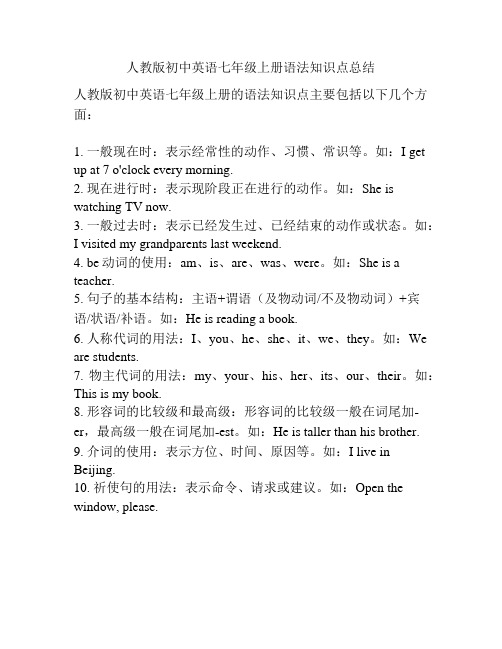
人教版初中英语七年级上册语法知识点总结
人教版初中英语七年级上册的语法知识点主要包括以下几个方面:
1. 一般现在时:表示经常性的动作、习惯、常识等。
如:I get up at 7 o'clock every morning.
2. 现在进行时:表示现阶段正在进行的动作。
如:She is watching TV now.
3. 一般过去时:表示已经发生过、已经结束的动作或状态。
如:
I visited my grandparents last weekend.
4. be动词的使用:am、is、are、was、were。
如:She is a teacher.
5. 句子的基本结构:主语+谓语(及物动词/不及物动词)+宾
语/状语/补语。
如:He is reading a book.
6. 人称代词的用法:I、you、he、she、it、we、they。
如:We are students.
7. 物主代词的用法:my、your、his、her、its、our、their。
如:This is my book.
8. 形容词的比较级和最高级:形容词的比较级一般在词尾加-er,最高级一般在词尾加-est。
如:He is taller than his brother. 9. 介词的使用:表示方位、时间、原因等。
如:I live in Beijing.
10. 祈使句的用法:表示命令、请求或建议。
如:Open the window, please.。
- 1、下载文档前请自行甄别文档内容的完整性,平台不提供额外的编辑、内容补充、找答案等附加服务。
- 2、"仅部分预览"的文档,不可在线预览部分如存在完整性等问题,可反馈申请退款(可完整预览的文档不适用该条件!)。
- 3、如文档侵犯您的权益,请联系客服反馈,我们会尽快为您处理(人工客服工作时间:9:00-18:30)。
人教版七年级上册英语语法整理一. 词汇4 r a9 ^( P, B) c0 r; w% n1 j/ |' K) q4 P9 c3 ^& h⑴! G. `. |8 V3 H# O- A单词' t0 K- c)Q/ }! K* }2 ~% h) A1. 介词:in, on, under, behind, near, at, of1). in表示在……中,在……内。
例如:+ c) S, ]4 R% b ?2 l# f6 X0 in our class 在我们班上in my bag 在我的书包里in the desk 在桌子里in the classroom 在教室里2). on 表示在……上。
例如:on the wall 在墙上on the desk 在桌子上 1 g* i; W3 Y8 L8W( k$ g* Xonthe blackboard 在黑板上3). under表示在……下。
例如:under the tree 在树下. }1 B: g/ P0 @2 G' H1 munder the chair在椅子下under the bed 在床下4). behind表示在……后面。
例如:0 \! S x* p% Q0 P: T/ ~日照365behind the door 在门后9 w-V3 [:Y ?3 f, {behind the tree 在树后5). near表示在……附近。
例如:5 O: j&near the teacher's desk 在讲桌附近near the bed 在床附近# c Y5 s6|/ `3 @* I f7 R6). at表示在……处。
例如:at school 在学校 6 \. U2 B: I! V4 fat home 在家at the door在门口1 / 8$ q( P; {% T+ f& I r5 a$ J7). of 表示……的。
例如:5 B9 I- m8 j Z$ \8 B$ x5 o: \( v9 ua picture of our classroom 我们教室的一幅画, s8 U B' g# C3 r0 z$ a map of China 一张中国地图日2. 冠词a / an / the:冠词一般位于所限定的名词前,用来署名名词所指的人或事物。
冠词有不定冠词和定冠词两种。
不定冠词有两个形式,即a和an。
a用在以辅音音素开头的词前,如a book; an用在以元音音素开头的字母前,如an apple.U, `9 v# I+ G, h$ r7 F6 r* c+ Ba或an与可数名词单数连用,泛指某类人或某物中的一个。
This is a cat. 6 o `, t5 p( J' U; o; G9 z& @2 {这是一只猫。
* ^- z) D$ A5 m0 HIt's an English book. 1 x. g. g! r( I) N日照365这是一本英语书。
His father is a worker.他的爸爸是个工人。
the既可以用在可数名词前,也可以用在不可数名词前,表示某个或某些特定的人或事物,也可以指上文提到过的人或事物。
Who's the boy in the hat? & h+ p7 o: S9 N1 _3 _% I6 k戴帽子的男孩是谁呀?' W/ Q( L5 G8 g$ a/ B( E-- What can you see in the classroom? --你能在教室里看到什么呀?-- I can see a bag. --我能看见一个书包。
-- Where's the bag? --书包在哪呀?9 x-- It's on the desk. ) @7 E c+ M& u4 R/ _9 J( l: ^ 2 t% o M0 g, r% z: f+ _' i6 ]6 Z日照365--在桌子上。
% Z! }4 K- X8 q8 M/ X3 i3.some和any2 / 8①在肯定句中用some.例如:There are some books on the desk.桌子上有一些书。
8 S# z& j: g0 ^! Y4 `% S0 ?+ P日照365Lucy has some good books露西有一些好书。
/ L! C$ u$ S) O+ B, }②在疑问句和否定句中用any。
例如:Is there any ink in your pen?你的钢笔里有墨水吗?) \! T9 h2 I# D* J E( vDo you have any brothers and sisters?你有兄弟姐妹吗?There isn't any water in the glass.杯子里没有水。
⑵记住它们的特殊用法。
①some亦可用于表示盼望得到对方肯定的答复或表示建议、委婉请求的疑问句中,这一点我们不久就会学到。
例如:Would you like to have some apples?你想吃苹果吗?②any也可用于肯定句中,表示任何的。
例如:Any one of us can do this.我们当中任何一个都能做这个。
% {- X5 T4 m0 E5 |. i% some 和any的用法是经常出现的考点,希望大家能准确地掌握它们的用法。
& ^ Z2 n. \7 C& @/ r) O* x4.familyfamily看作为一个整体时,意思是家庭,后面的谓语动词be用单数形式is ;如把family看作为家庭成员时,应理解为复数,后面的谓语动词be应用are。
. b v g, ~2 H9 lMy family is a big family. 我的家庭是个大家庭。
M, c- }- `$ w2 y J `* k日照365My family are all at home now. 我的家人现在都在家。
3 / 8* f7 B0 k8 \% OFamily强调由家人组成的一个集体或强调这个集体中的成员。
home指个人出生、被抚养长大的环境和居住地点。
house 指家、房屋,侧重居住的建筑本身。
0 N* b5 ?8 D- V! b! b) dHis family are all workers. 他的家人都是工人, @& j; ^% {$ b) K0 My home is in . 我的家在北京。
He isn't at home now. 他现在不在家。
2 l. \5 [* q: Y. I5 }# a5 A$ FIt's a picture of my family. 这是一张我全家的照片。
& |4 c3 ^- n! @& x( V9 N: g5 O& d' x; D; w8 @6 @5 W8 k; t2 E5. little的用法+a little dog 一只小狗,a little boy 一个小男孩。
little常用来修饰有生命的名词。
8 g4 B2 O& d. f! {% x( *但little还可表示否定意义,意为少的,加不可数名词。
y' v: G' V4 X6 TThere is little time. 几乎没时间了。
There is little water in the cup. 杯中水很少。
⑵# L; i7 [, N! o9 g词组on the desk 在桌子上1 Z behind the chair 在椅子后under the chair 在椅子下面in her pencil-box 在她的铅笔盒中z1 h* s' _* x* c+ W2 Cnear the door 在门附近a picture of a classroom 一个教室的图片look at the picture 看这张图片the teacher's desk 讲桌 a map of China 一张中国地图family tree家谱/ f+ G$ h/ h* e7 ?( _% Lhave a seat 坐下,就坐this way 这边走4 / 8& S. E& N/ Y, e- s; H* ~* W0 g% N- p( t! E二. 日常用语V- |/ b4 d/ S4 D! s; g6 T* T8 P日照3651. Come and meet my family.. F: s: K# U' g6 e# B- } Q2. Go and see. I think it's Li Lei.! {/ w5 m% s' K日照3653. Glad to meet you.( R* }% C! D3 e( g d- Y5 ]4. What can you see in the picture? I can see a clock /some books.6 Z7 J) W/ O/ Q8 R; [5. Can you see an orange? Yes, I can. / No, I can't.3 u ]$ E1 I$ {. n; s6. Where's Shenzhen? It's near .8 b* ^* p, | I2 f( V! C/ G9 T Z2 7. Let me see.(口语)让我想想看。
7 ^. D/ _- t% `. ]' y* j8 psee 在这是明白、懂了,不可译作看见。
For example :8. Please have a seat. seat表示座位,是个名词。
have a seat表示就坐,也可以说take a seat, 和sit down的意思相同。
: R0 l3 b2 |/ K0 r3 O+ y: ]三. 语法9 [, U, d' I9 f8 b8 b3 }1. 名词所有格2 @. E, @9 a/ e& f% s8 ]3 |6 ~; J名词如要表示与后面名词的所有关系,通常用名词所有格的形式,意为……的。
一般有以下几种形式) D) ^& W7 f! A$ e4 I9 w! a7 u(1). 一般情况下在词尾加?环。
例如Kate's father Kate的爸爸3 B/ a* l; ]/ s4 t. L* mmy mother's friend 我妈妈的朋友(2). 如果复数名词以s结尾,只加?岯。
例如Teachers' Day 教师节5 / 81 h$ X0 v$ v1 S% t0 |The boys' game 男孩们的游戏$ `0 \0 m1 R% N+ F(3). 如果复数名词不以s结尾,仍加?环。
